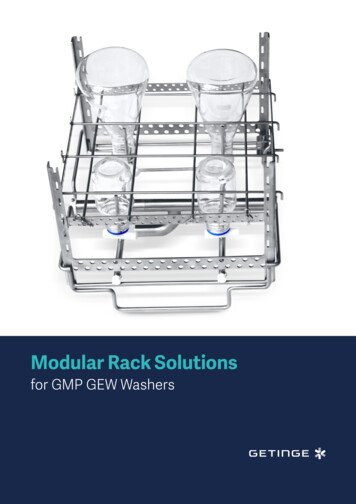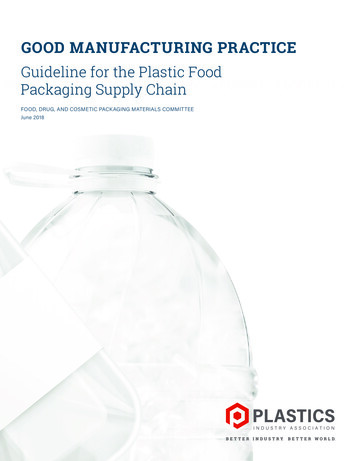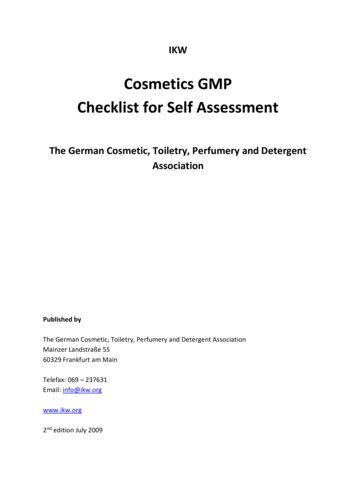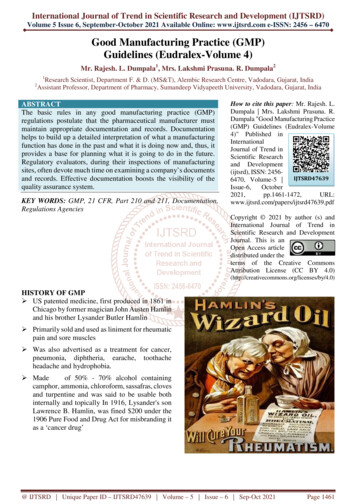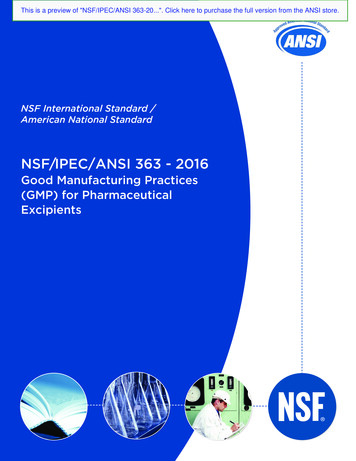
Transcription
This is a preview of "NSF/IPEC/ANSI 363-20.". Click here to purchase the full version from the ANSI store.NSF International Standard /American National StandardNSF/IPEC/ANSI 363 - 2016Good Manufacturing Practices(GMP) for PharmaceuticalExcipients
This is a preview of "NSF/IPEC/ANSI 363-20.". Click here to purchase the full version from the ANSI store.NSF International, an independent, notfor-profit, non-governmental organization,is dedicated to being the leading globalprovider of public health and safetybased risk management solutions whileserving the interests of all stakeholders.This Standard is subject to revision.Contact NSF to confirm this revision is current.Users of this Standard may request clarifications andinterpretations, or propose revisions by contacting:Chair, Joint Committee on Pharmaceutical Excipientsc/o NSF International789 North Dixboro Road, P. O. Box 130140Ann Arbor, Michigan 48113-0140 USAPhone: (734) 769-8010 Telex: 753215 NSF INTLFAX: (734) 769-0109E-mail: info@nsf.orgWeb: http://www.nsf.org
This is a preview of "NSF/IPEC/ANSI 363-20.". Click here to purchase the full version from the ANSI store.NSF International Standard/International PharmaceuticalExcipients Council/American National Standardfor Pharmaceutical Excipients –Good ManufacturingPractices (GMP) forPharmaceutical ExcipientsStandard DeveloperNSF InternationalNSF InternationalDesignated as an ANSI StandardJuly 7, 2016American National Standards Institutei
This is a preview of "NSF/IPEC/ANSI 363-20.". Click here to purchase the full version from the ANSI store.Prepared byThe NSF Joint Committee on Pharmaceutical ExcipientsAdoptedDecember 2014Revised January 2017Published byNSF InternationalPO Box 130140, Ann Arbor, Michigan 48113-0140, USAFor ordering copies or for making inquiries with regard to this Standard, please reference the designation“NSF/IPEC/ANSI 363 – 2016.”Copyright 2017 NSF InternationalPrevious editions 2014Unless otherwise specified, no part of this publication may be reproduced or utilized in any form or by anymeans, electronic or mechanical, including photocopying and microfilm, without permission in writing fromNSF International.Printed in the United States of America.ii
This is a preview of "NSF/IPEC/ANSI 363-20.". Click here to purchase the full version from the ANSI store.Disclaimers1NSF, in performing its functions in accordance with its objectives, does not assume or undertake todischarge any responsibility of the manufacturer or any other party. The opinions and findings of NSFrepresent its professional judgment. NSF shall not be responsible to anyone for the use of or relianceupon this Standard by anyone. NSF shall not incur any obligation or liability for damages, includingconsequential damages, arising out of or in connection with the use, interpretation of, or reliance uponthis Standard.NSF Standards provide basic criteria to promote sanitation and protection of the public health. Provisionsfor mechanical and electrical safety have not been included in this Standard because governmentalagencies or other national standards-setting organizations provide safety requirements.Participation in NSF Standards development activities by regulatory agency representatives (federal,local, state) shall not constitute their agency's endorsement of NSF or any of its Standards.Preference is given to the use of performance criteria measurable by examination or testing in NSFStandards development when such performance criteria may reasonably be used in lieu of design,materials, or construction criteria.The illustrations, if provided, are intended to assist in understanding their adjacent standard requirements.However, the illustrations may not include all requirements for a specific product or unit, nor do they showthe only method of fabricating such arrangements. Such partial drawings shall not be used to justifyimproper or incomplete design and construction.Unless otherwise referenced, the annexes are not considered an integral part of NSF Standards. Theannexes are provided as general guidelines to the manufacturer, regulatory agency, user, or certifyingorganization.The information contained in this Disclaimer is not part of this American National Standard (ANS) and has not beenprocessed in accordance with ANSI’s requirements for an ANS. Therefore, this Disclaimer may contain material thathas not been subjected to public review or a consensus process. In addition, it does not contain requirementsnecessary for conformance to the Standard.1iii
This is a preview of "NSF/IPEC/ANSI 363-20.". Click here to purchase the full version from the ANSI store.This page is intentionally left blank.
This is a preview of "NSF/IPEC/ANSI 363-20.". Click here to purchase the full version from the ANSI store.Contents1General . 11.1 Introduction . 11.2 Scope . 11.3 Purpose . 22Reference documents . 22.1 Normative references . 22.2 Informational references . 23Definitions . 34Quality management system . 84.1 General requirements . 84.2 Documentation requirements . 94.3 Change control . 105Management responsibility . 115.1 Management commitment. 115.2 Customer focus . 115.3 Quality policy . 115.4 Planning . 125.5 Responsibility, authority, and communication . 125.6 Management review . 136Resource management . 146.1 Provision of resources. 146.2 Human resources . 146.3 Infrastructure . 156.4 Work environment . 177Excipient realization . 187.1 Planning of excipient realization . 187.2 Customer-related processes . 197.3 Design and development (out of scope) . 197.4 Purchasing . 197.5 Production and service provision . 207.6 Control of monitoring and measuring equipment . 238Measurement, analysis and improvement . 238.1 General. 238.2 Monitoring and measurement . 238.3 Control of nonconforming product . 278.4 Analysis of data . 298.5 Improvement . 29v
This is a preview of "NSF/IPEC/ANSI 363-20.". Click here to purchase the full version from the ANSI store.This page is intentionally left blank.
This is a preview of "NSF/IPEC/ANSI 363-20.". Click here to purchase the full version from the ANSI store.Foreword2The purpose of NSF/IPEC/ANSI 363 is to serve as an evaluation tool for analyzing pharmaceuticalexcipients. Certification to this Standard serves as a communication tool between manufacturers ofexcipients and finished product, pharmaceutical regulators, pharmacy organizations, and consumers.This Standard provides guidance to allow for the determination that a pharmaceutical excipient is withinthe specifications stated by the manufacturer, either qualitatively or quantitatively, and that it does notcontain specific undeclared contaminants. In some instances, validated laboratory methods are not yetavailable for analyzing certain ingredients. In such cases, new methods will be added to this Standard asthey become available.NSF/IPEC/ANSI 363 was developed with participation from the pharmaceutical excipients manufacturers,public health regulators, and distributors of pharmaceutical excipients.This edition of the Standard contains the following revisions:Issue 2This revision updated section 4.1.1 regarding regional regulations.Issue 3Updates were made to language regarding the use of the terms “product” and “excipient.Issue 4Definitions for the terms deviation and sanitary were added to section 3.Issue 5This revision provides clarity on language in section 6.3.2.1 and 6.3.3.Issue 6Updates to section 7.4.1 were made regarding the purchasing process.Issue 7Section 7.2.1 was updated to provide clarity.Issue 8This revision made several editorial changes throughout the Standard.Issue 9A definition for the term data integrity was added to section 3.The information contained in this Foreword is not part of this American National Standard (ANS) and has not beenprocessed in accordance with ANSI’s requirements for an ANS. Therefore, this Foreword may contain material thathas not been subjected to public review or a consensus process. In addition, it does not contain requirementsnecessary for conformance to the Standard.2vii
This is a preview of "NSF/IPEC/ANSI 363-20.". Click here to purchase the full version from the ANSI store.Issue 10A definition for the term backup was added to section 3.Suggestions for improvement of this Standard are welcome. This Standard is maintained on a ContinuousMaintenance schedule and can be opened for comment at any time. Comments should be sent to Chair,Joint Committee on Pharmaceutical Excipients at standards@nsf.org, or c/o NSF International, StandardsDepartment, P.O. Box 130140, Ann Arbor, Michigan 48113-0140, USA.viii
This is a preview of "NSF/IPEC/ANSI 363-20.". Click here to purchase the full version from the ANSI store. 2017 NSFNSF/IPEC/ANSI 363 – 2016NSF/IPEC/ANSI Standardfor Pharmaceutical Excipients –Good Manufacturing Practices (GMP)for Pharmaceutical Excipients1 General1.1 IntroductionThe principles outlined in this Standard provide a comprehensive basis for the quality managementsystem used in the manufacture of pharmaceutical excipients. Implementation of these principles shallresult in the achievement of three main objectives:a) achieve excipient realization – the organization shall implement and maintain a system thatdelivers excipients with the quality attributes necessary to meet the requirements and expectations ofcustomers, pharmaceutical users, and regulatory authorities;b) establish and maintain a state of control – the organization shall ensure the manufacture andsupply of excipients is in accordance with this Standard, thus providing customers with someassurance of continued suitability and reliability of supply; andc) facilitate continual improvement – the organization shall collect objective evidence to continuallydevelop and enhance the application of these quality management system principles to further assureexcipient consistency.1.2 ScopeThis Standard is intended to define Good Manufacturing Practices (GMP) for excipient manufacture anddistribution3 for use in drug products. It sets minimum requirements for GMP applicable to allcommercially available excipients.This Standard includes the minimum requirements of a quality management system for excipientmanufacture drawing on principles of GMP and quality systems from other relevant standards such asthose referenced in section 2.2.NOTE 1 — The requirements of this Standard may not be sufficient for all applications of excipients. It is theuser's responsibility to determine whether or not this Standard meets the requirements for their intendeduse.NOTE 2 — Auditing excipient manufacturers ensures conformance to this Standard. This Standard is alsointended to be used by duly accredited or otherwise suitably qualified 3 rd parties.NOTE 3 — Each user of a 3rd party auditing service should make its own determination as to thequalifications of the 3rd party and the applicability of the report and/or certificate issued in satisfying itsrequirements, including those pertaining to its intended use of the excipient.3GMP applies to distribution per the Federal Food, Drug, and Cosmetic Act (FD&C Act), 21 U.S.C. 501(a) (2) (B).1
NSF/IPEC/ANSI 363 was developed with participation from the pharmaceutical excipients manufacturers, public health regulators, and distributors of pharmaceutical excipients. This edition of the Standard contains the following revisions: Issue 2 . This revision updated section 4.1.1 regarding regional regulations. Issue 3


